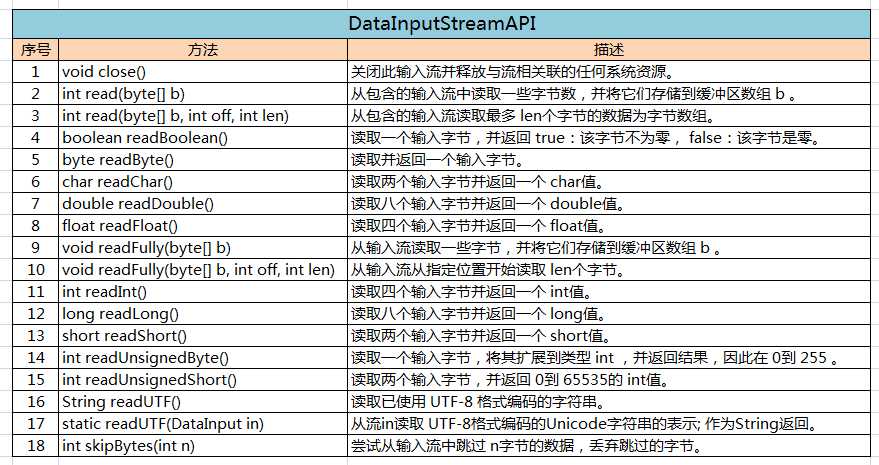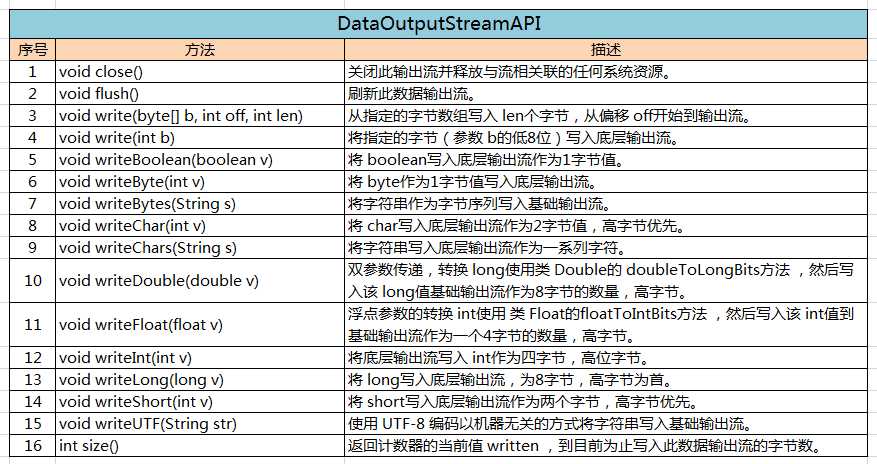Java IO(十一) DataInputStream 和 DataOutputStream
2021-01-15 16:14
标签:数据 character 遍历 ascii码 mic str 基于 nts bre DataInputStream 和 DataOutputStream 是数据字节流,分别继承自 FilterInputStream 和 FilterOutputStream 和 实现了 DataInput 和 DataOutput。用来装饰其他的字节流。 DataInputStream 和 DataOutputStream 关于编码有关的方法,分别是 String readUTF() 和 void writeUTF(String str)。下面就这个两个方法说明一下编码问题 DataOutputStream 的 writeUTF 方法是将以 UTF-8 的编码格式的数据写入底层输出流中。具体流程如下: ①、定义一个 strlen 变量,存储字符串的长度 int strlen = str.length(); ②、通过 for 循环遍历 str ,根据c的大小决定存储长度utflen的大小,最大65535字节,也就是64kb,超出最大字节会抛出 UTFDataFormatException 异常。 ③、定义一个byte数组类型的变量 bytearr,判断该数据输出流是否是 DataOutputStream,若是则: 设置bytearr的大小。+2是需要在 bytearr 前两字节中存储数据长度 utflen。 ④、根据字符串的字符的字节数分别放入 bytearr 数组中 源码基于JDK1.8,上面只贴出主要源码,详细源码自行查看 DataOutputStream 类。 上面知道了写入的规则,DataInputStream 的 String readUTF() 读取的规则与写入的规则相反。 ①、定义 utflen 变量读取输入流中UTF-8数据的长度: int utflen = in.readUnsignedShort(); ②、创建字符数组 bytearr 和 字节数组 chararr ③、判断该数据输入流是否是 DataInputStream ,若是,则: 否则,新建数组 bytearr 和 chararr。 ④、将UTF-8数据全部读取到字节数组 bytearr 中通过 readFully() 方法: in.readFully(bytearr, 0, utflen); ⑤、对UTF-8中单字节数据进行预处理,UTF-8的数据是变长的,可以是1-4个字节;在readUTF()中,我们最终是将全部的UTF-8数据保存到字符数组(而不是字节数组)中,再将其转换为String字符串。 ⑥、对预处理后的数据进行再处理 ⑦、将字符数组 chararr 转成 String类型返回: return new String(chararr, 0, chararr_count); Java IO(十一) DataInputStream 和 DataOutputStream 标签:数据 character 遍历 ascii码 mic str 基于 nts bre 原文地址:https://www.cnblogs.com/lingq/p/12925197.htmlJava IO(十一) DataInputStream 和 DataOutputStream
一、介绍
二、构造方法
(一)、DataInputStream
public DataInputStream(InputStream in) //创建使用指定的底层 InputStream 的输入数据流
(二)、DataOutputStream
public DataOutputStream(OutputStream out) // 创建一个使用指定底层 OutputStream 的数据输出流,以将数据写入指定的底层输出流。
三、常用API
(一)、DataInputStream

(二)、DataOutputStream

四、DataInputStream 和 DataOutputStream 的编码问题
(一)、DataOutputStream 的 void writeUTF(String str)
for (int i = 0; i ) {
c = str.charAt(i);
if ((c >= 0x0001) && (c )) {
utflen++; // 单字节
} else if (c > 0x07FF) {
utflen += 3;// 三字节
} else {
utflen += 2; // 两字节
}
}byte[] bytearr = null;
if (out instanceof DataOutputStream) {
DataOutputStream dos = (DataOutputStream)out;
if(dos.bytearr == null || (dos.bytearr.length )))
dos.bytearr = new byte[(utflen*2) + 2];
bytearr = dos.bytearr;
} else {
bytearr = new byte[utflen+2];
}
int i=0;
// 如果是ascii码就直接存在 bytearr 数组中
for (i=0; i
// 如果是单字节
bytearr[count++] = (byte) c;
} else if (c > 0x07FF) {
// 三字节
bytearr[count++] = (byte) (0xE0 | ((c >> 12) & 0x0F));
bytearr[count++] = (byte) (0x80 | ((c >> 6) & 0x3F));
bytearr[count++] = (byte) (0x80 | ((c >> 0) & 0x3F));
} else {
// 两字节
bytearr[count++] = (byte) (0xC0 | ((c >> 6) & 0x1F));
bytearr[count++] = (byte) (0x80 | ((c >> 0) & 0x3F));
}
}
out.write(bytearr, 0, utflen+2);
return utflen + 2; // 返回 bytearr 数组大小(二)、DataInputStream 的 String readUTF()
byte[] bytearr = null;
char[] chararr = null;
if (in instanceof DataInputStream) {
DataInputStream dis = (DataInputStream)in;
if (dis.bytearr.length utflen){
dis.bytearr = new byte[utflen*2];
dis.chararr = new char[utflen*2];
}
chararr = dis.chararr;
bytearr = dis.bytearr;
} else {
bytearr = new byte[utflen];
chararr = new char[utflen];
}
由于UTF-8的单字节和ASCII相同,所以这里就将它们进行预处理,直接保存到字符数组 chararr 中。对于其它的UTF-8数据,则在后面进行处理。while (count utflen) {
c = (int) bytearr[count] & 0xff; // 将每字节转成 int 值
if (c > 127) break; // UTF-8单子节数据不会超过127,超过则退出
count++;
chararr[chararr_count++]=(char)c;// 将int转成char存入字符数组
}
while (count utflen) {
c = (int) bytearr[count] & 0xff; // 将字节有 byte 转成 int
switch (c >> 4) { // 将 int 类型左移 4 位
case 0: case 1: case 2: case 3: case 4: case 5: case 6: case 7:
/* 若UTF-8是单字节数据,则 bytearr[count] 的格式:0xxxxxxx,对应 int 类型的字符 c 取值范围:0-7 */
count++;
chararr[chararr_count++]=(char)c;
break;
case 12: case 13:
/* 若UTF-8是两字节数据,则 bytearr [count]的格式:110x xxxx 10xx xxxx,对应 int 类型的字符 c 的取值范围:12-13*/
count += 2;
if (count > utflen)
throw new UTFDataFormatException("malformed input: partial character at end");
char2 = (int) bytearr[count-1];
if ((char2 & 0xC0) != 0x80)
throw new UTFDataFormatException("malformed input around byte " + count);
chararr[chararr_count++]=(char)(((c & 0x1F) (char2 & 0x3F));
break;
case 14:
/* 若UTF-8是三字节数据,则 bytearr[count] 的格式:1110 xxxx 10xx xxxx 10xx xxxx,对应 int 类型的字符 c 的取值范围是:14 */
count += 3;
if (count > utflen)
throw new UTFDataFormatException("malformed input: partial character at end");
char2 = (int) bytearr[count-2];
char3 = (int) bytearr[count-1];
if (((char2 & 0xC0) != 0x80) || ((char3 & 0xC0) != 0x80))
throw new UTFDataFormatException("malformed input around byte " + (count-1));
chararr[chararr_count++]=(char)(((c & 0x0F) ((char2 & 0x3F) ((char3 & 0x3F) ));
break;
default:
/* 若UTF-8是四字节的数据,则bytearr[count] 的格式:10xx xxxx,1111 xxxx,对应 int 类型的字符 c 的取值范围是:15 */
throw new UTFDataFormatException("malformed input around byte " + count);
}
}五、实例
public static void main(String[] args) {
write();
read();
}
/**
* DataInputStream 测试
*/
public static void read() {
DataInputStream in = null;
try {
in = new DataInputStream(new FileInputStream("data.txt"));
System.out.println("readUTF : " + in.readUTF());
System.out.println("read : " + (char)in.read());
System.out.println("readBoolean : " + in.readBoolean());
System.out.println("readDouble : " + in.readDouble());
System.out.println("readFloat : " + in.readFloat());
System.out.println("readByte : " + in.readByte());
System.out.println("readChar : " + in.readChar());
System.out.println("readLong : " + in.readLong());
System.out.println("readLong : " + in.readLong());
}catch(Exception e) {
e.printStackTrace();
}finally {
try {
if (in != null)
in.close();
}catch (Exception e) {
e.printStackTrace();
}
}
}
/**
* DataOutputStream 测试
*/
public static void write() {
DataOutputStream out = null;
try {
out = new DataOutputStream(new FileOutputStream("data.txt"));
out.writeUTF("Java IO 入门");
out.write(‘A‘);
out.writeBoolean(true);
out.writeDouble(3.14D);
out.writeFloat(0.69F);
out.write("abcdefg".getBytes());
out.writeByte(99);
out.writeChars("Hello World");
out.writeLong(46L);
out.writeBytes("data input stream");
}catch(Exception e) {
e.printStackTrace();
}finally {
try {
if (out != null)
out.close();
}catch (Exception e) {
e.printStackTrace();
}
}
}
文章标题:Java IO(十一) DataInputStream 和 DataOutputStream
文章链接:http://soscw.com/index.php/essay/42313.html